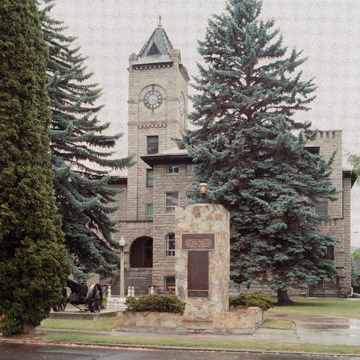Baker County Courthouse, one of several Oregon courthouses designed by Delos D. Neer, is one of the largest and most imposing public buildings in Baker City. Settlement of the area began in 1861, with the discovery of gold along the Powder River, and the region enjoyed modest prosperity until around 1910, when the deposits began to be exhausted, and settlement shifted further south along the river. In the interim, because of the influx of people involved in mining and supporting businesses, this portion of then-huge Wasco County was divided off by the Oregon state legislature and made Baker County. The name honored Edward D. Baker, a U.S. Senator from Oregon who was killed in the Battle of Ball’s Bluff, one of the earliest battles of the Civil War. The new developing community on the Powder River, platted in 1865, was similarly named Baker City.
Population growth was somewhat limited, though the city was incorporated in 1874. Baker City prospered once the Oregon Short Line Railroad, an independent branch line connecting to the Northern Pacific, was built through the town in 1884. The population swelled to around 6,000, and the city, which was then the largest settlement between Salt Lake City and Portland, was designated the county seat. Little is known about the first accommodations for county business, but in 1906 the county hired Neer to design a new courthouse. By then Neer had designed four other Oregon county courthouses (for Umatilla, Benton, Lane, and Polk counties).
Baker County Courthouse is Richardsonian Romanesque in style, with an L-shaped plan and broad entrance stair that leads to a wide, low-slung, round-arched entrance on the inside corner of the L, at the base of a tall tower. The quarry-faced masonry was markedly Richardsonian, though the blocks were not of the huge size Richardson customarily used. The stone is a local gray volcanic rock called tuff, quarried a few miles south of town and used in many locations in eastern Oregon. Rather soft when first cut and used for construction, tuff then hardens on exposure to the air. Little is known about Neer, although his last three county courthouse commissions—including Baker County Courthouse—demonstrate a distinct plan and style that has served these counties well over more than a century of service.














